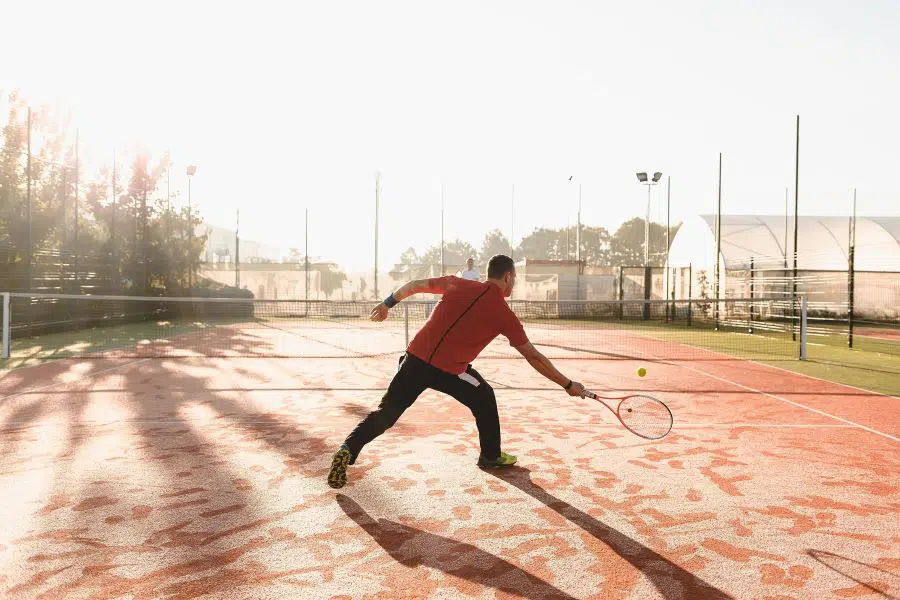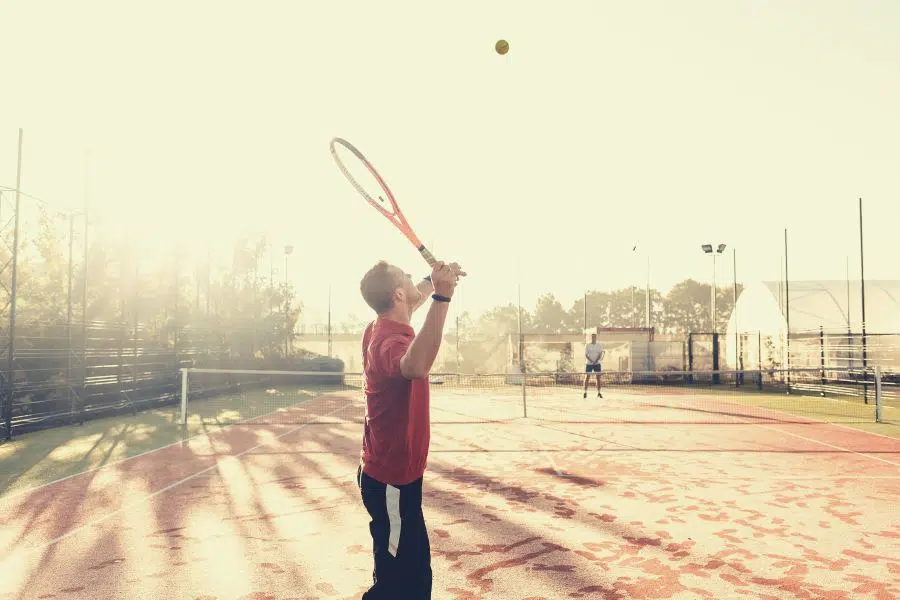Engineering theory and the laws of physics are probably not at the forefront of your mind when playing tennis. Yet, how a tennis ball moves in flight and how it responds to spin depends on such theories and laws. When you strike the ball at the right angle you can get the ball to significantly curve and dip.
The Magnus effect explains how a tennis ball curves during flight, depending on the direction of rotation of the ball. Using spin, a tennis player can utilize the Magnus effect to move the ball around the court in a way which makes it harder to combat.
Understanding how the Magnus effect impacts the flight of a tennis ball offers a considerable advantage to a player. This article will look at what the Magnus effect is and how it relates to the different spin and shots seen within tennis.

What Is the Magnus Effect?
The Magnus effect explains how a ball in sport curves. It is named after the 19th century German physicist Heinrich Gustav Magnus, who wanted to understand why projectiles such as cannonballs curved in flight. However, Magnus had not been the first to take an interest in the topic.
As far back as the 17th century a certain Isaac Newton was watching a game of tennis in Cambridge.
He also took note of how the ball responded differently depending on the spin. In commenting on this phenomenon he was to infer the same observations as Magnus two centuries later, following the German’s more extensive investigation.
So what did Newton and Magnus see all those years ago while watching their different projectiles travel?
They noticed that when a ball is propelled forward and rotates clockwise, air runs over it and provides resistance by exerting a drag force. As the ball spins, one side moves in the direction of the airflow, while the other side moves against the direction of the airflow (source).
Newton and his third law of motion comes in to play at the point when the air moving over the ball is deflected down toward the slower air on the other side of the ball.
A downward force is applied to the air, and as Newton stated, every action has an equal and opposite reaction. Therefore the downward force on the air produces an upward force on the ball.
How Does the Magnus Effect Apply to Tennis?
When you strike a tennis ball you often generate spin, with the Magnus effect imparting an additional force on the spinning ball (source).
The side of the ball with the faster air flow will have lower air pressure compared to the side of the ball with the slower air flow. It is the difference in this pressure which sees the ball move in the direction of the side with the lower pressure, which will be the direction of the spin.
The force on the ball to create this movement is known as the Magnus force. Knowing how the different spin can move the ball is crucial for any tennis player.
Knowing you can unleash a full-blooded forehand which will drop in to the court because of the spin imparted becomes a serious weapon.
Rafael Nadal is a prime example when looking for someone taking full advantage of the Magnus effect. When he uncoils one of his ferocious topspin forehands he moves the racket forward and up, whipping it through the ball in order to create the topspin required to ensure the ball curves down in to the court.
Not only does the ball arrive at the opponent at pace, it is also deflecting down late towards the opponents feet before bouncing on up at them.
A tennis ball when struck has a high degree of friction, which combined with the spin helps to redirect the ball.
A forehand such as Nadal’s relies on topspin to control the flight of the ball, whereas a sliced return will create backspin on the ball.
I shall take a look how the Magnus effect impacts on both topspin and backspin.

Topspin and the Magnus Effect
Topspin is a critical element for both the forehand and backhand, and the variety of spin you will see employed most in the pro game.
Using Nadal again as an example, his forehand propels the ball at a ridiculous 5,000 spins per minute or so.
The rest of us mere mortals will never get anywhere near generating this level of topspin on a ball, but that does not mean we can’t use topspin as an effective tool.
When you use topspin you propel the tennis ball with forward rotation. This is achieved by rotating the racket over the top of the ball as it is struck.
Without spin and the Magnus effect the sheer pace with which the ball is struck would see it sail long every time, handing the point to your opponent. However, the drag on the ball generated by the forward rotation ensures the shot curves and dips down within the court line.
The pro players can play such big forehand and backhand topspin shots because they know the additional downward drag on the ball will keep it in play.
The ball has a higher, looping trajectory before being dragged down inside the court line. The late dip and bounce makes the return harder for your opponent and allows you to gain more control of the rally.
Using Backspin
As you would expect, backspin propels the ball with a backward rotation. To generate backspin a player slices under the ball, sliding the racket beneath the ball as they strike.
The drag generated by the Magnus effect from the backward rotation sees the ball stay lower compared to topspin, and also sees the ball travel further.
Therefore, while a topspin shot rises before deflecting downwards, backspin sees the ball stay longer in the air.
A slice shot is more about caressing the ball rather than power to ensure the ball does not go long. The lower trajectory means there is less margin for error over the net, but it makes the return difficult to dig out as the ball also stays low on the bounce.
Roger Federer is a great exponent of the one-handed backhand slice. However the slice can be played either one-handed or two-handed and the Magnus effect will still apply.
The swing for the slice goes from high to low, striking toward the bottom of the ball. It is key to keep the momentum of the swing going after contact to ensure you maximize the spin on the ball.
A Flat Hit
If you hit a ball without spin then the Magnus force does not come in to play.
Such flat hits obviously do not travel in a straight, continuous line. The laws of physics still apply, just that the lack of spin does not produce the unequal drag on different sides of the ball to cause the movement seen with the Magnus effect.
There is still drag on a ball without spin, which acts in the opposite direction to the ball’s movement. The outcome is the trajectory of a flat hit will not have the height of a topspin shot, but will have more margin of error over the net than the lower trajectory of a sliced shot using backspin.
Conclusion
By understanding the Magnus effect a tennis player has a better appreciation of how the ball will react to different types of shots.
Any spin imparted on the ball will bring the Magnus effect in to play. A tennis player with an understanding of the Magnus effect can better manipulate the movement of the ball and make the returns more difficult for their opponent,
Like any other aspect of the game, learning how to strike the ball correctly to generate the spin required takes practice. Perfecting your swing and how to strike the ball in the right spot and at the right angles will see you benefit more from the spin you generate.
Whether for your serve, forehand, backhand or even your smash, learning how to utilize the Magnus effect will maximize the advantage of the spin you impart on the ball.
